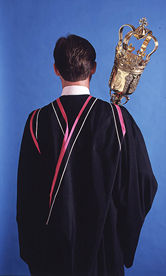From early aboriginal gatherings to parliamentary processions, we have used big sticks to communicate power and authority. And no matter how we dress these sticks up now, there’s no escaping the primitive origins of maces. They first appeared during the Bronze Age as weapons, but centuries later the perceived clout of the person carrying them was enough to keep people in line; and so the big sticks evolved into works of art. The mace of Britain’s Lord Mayor of London, for instance, is embellished with crystal and pearls. The University of Toronto’s most recent mace is gold-plated silver and was also made in London. It was a gift from Lt.-Col. Eric Phillips (chair of the Board of Governors – now called Governing Council – from 1945 to 1964) and unveiled at the June 1951 convocation. Every year thousands of graduands see it reverently carried into Convocation Hall by the beadle (designated mace holder) to officially begin the ceremony. Under the mace’s crown is a cushion bearing the coat of arms of George IV (who granted the university’s first charter in 1827), while the bowl underneath has bands decorated with maple leaves and trilliums. As the mace is turned, there are panels that reveal the cipher used by King George IV, then the arms of Canada, Ontario and U of T. Additional images of crosses, fleurs-de-lys and beavers reveal U of T’s cultural origins and influences. Other than engineering’s Lady Godiva Band, the artist seems to have covered just about everything.
Recent Posts
U of T’s 197th Birthday Quiz
Test your knowledge of all things U of T in honour of the university’s 197th anniversary on March 15!
Are Cold Plunges Good for You?
Research suggests they are, in three ways
Work Has Changed. So Have the Qualities of Good Leadership
Rapid shifts in everything from technology to employee expectations are pressuring leaders to constantly adapt





